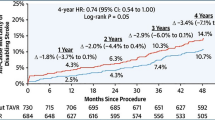Abstract
Background
Implantable cardioverter-defibrillator (ICD) implantation is often an elective outpatient procedure, but previous studies have shown that approximately 30% are performed during acute hospitalizations.
Purpose
This study aims to identify predictors of acute hospitalization versus elective outpatient ICD implantation and evaluate differential clinical outcomes.
Methods
We studied 327 first-time ICD recipients between 2011 and 2015. All patients receiving a primary prevention ICD were optimized on guideline directed medical therapy (GDMT) prior to consideration for device implantation. Using multivariate logistic regression, we examined predictors of ICD implantation during acute hospitalization. Cox proportional hazard regression was used adjusting for patient characteristics to examine associations with clinical outcomes including complications, device therapy, heart failure re-admission, and death.
Results
Of all patients, 132 (40.3%) underwent ICD implantation during acute hospitalization, most frequently performed for secondary prevention (n = 76, 57.6%). The most common reason for acute hospitalization ICD implantation in primary prevention patients was an indication for pacing (n = 20, 35.7%). In multivariable adjusted models, secondary prevention indication, non-single chamber device, NYHA class IV symptoms, lower diastolic blood pressure, higher BUN, and lower hemoglobin were significant predictors of ICD implantation during an acute hospitalization. In univariate analysis, acute hospitalization ICD implantation was associated with a higher risk of heart failure re-admission (HR = 1.6, 95% CI 1.1–2.4) and mortality (HR = 3.0, 95% CI 1.1–8.0) but no difference in risk of ICD therapy (HR = 1.4, 95% CI 0.9–2.3) or adverse events (HR = 1.1, 95% CI 0.6–2.1). After multivariable adjustment for potential confounders, all outcomes were no different between acute hospitalization versus elective outpatient ICD recipients.
Conclusions
Among first-time ICD recipients, specific clinical characteristics predicted acute hospitalization ICD implantation. After adjustment for potential confounders, acute hospitalization ICD implantation was not associated with increased risk of morbidity or mortality.

Similar content being viewed by others
Abbreviations
- ICD:
-
Implantable cardioverter-defibrillator
- VF:
-
Ventricular fibrillation
- VT:
-
Ventricular tachycardia
- SCD:
-
Sudden cardiac death
- NYHA:
-
New York Heart Association
- CI:
-
Confidence interval
- CRT-D:
-
Cardiac resynchronization therapy with defibrillator
- ICD:
-
Implantable cardioverter-defibrillator
- HR:
-
Hazard ratio
- OR:
-
Odds ratio
References
Bardy GH, Lee KL, Mark DB, et al. Amiodarone or an implantable cardioverter–defibrillator for congestive heart failure. N Engl J Med. 2005;352(3):225–37. https://doi.org/10.1056/NEJMoa043399.
Moss AJ, Hall WJ, Cannom DS, et al. Improved survival with an mplanted defibrillator in patients with coronary disease at high risk for ventricular arrhythmia. N Engl J Med. 1996;335(26):1933–40. https://doi.org/10.1056/NEJM199612263352601.
Connolly SJ, Gent M, Roberts RS, et al. Canadian Implantable Defibrillator Study (CIDS): a randomized trial of the implantable cardioverter defibrillator against amiodarone. Circulation. 2000;101(11):1297–302. https://doi.org/10.1161/01.cir.101.11.1297.
Zipes DP, Wyse DG, Friedman PL, et al. A comparison of antiarrhythmic-drug therapy with implantable defibrillators in patients resuscitated from near-fatal ventricular arrhythmias. The Antiarrhythmics versus Implantable Defibrillators (AVID) investigators. N Engl J Med. 1997;337(22):1576–83. https://doi.org/10.1056/NEJM199711273372202.
Rthur A, Oss JM, Ackson WJ, et al. Improved survival with an implanted defibrillator in patients with coronary disease at high risk for ventricular arrhythmia. 1933;335(335).
Russo AM, Stainback RF, Bailey SR, et al. ACCF/HRS/AHA/ASE/HFSA/SCAI/SCCT/SCMR 2013 appropriate use criteria for implantable cardioverter-defibrillators and cardiac resynchronization therapy. J Am Coll Cardiol. 2013;61(12):1318–68. https://doi.org/10.1016/j.jacc.2012.12.017.
Epstein AE, DiMarco JP, Ellenbogen KA, et al. ACC/AHA/HRS 2008 guidelines for device-based therapy of cardiac rhythm abnormalities. Hear Rhythm. 2008;5(6):934–55. https://doi.org/10.1016/j.hrthm.2008.04.015.
Hsu JC, Varosy PD, Parzynski CS, et al. Procedure timing as a predictor of inhospital adverse outcomes from implantable cardioverter-defibrillator implantation: insights from the National Cardiovascular Data Registry. Am Heart J. 2014;169(1):45–52.e3. https://doi.org/10.1016/j.ahj.2014.10.006.
Hsu JC, Marcus GM, Al-Khatib SM, et al. Predictors of an inadequate defibrillation safety margin at ICD implantation: insights from the national cardiovascular data registry. J Am Coll Cardiol. 2014;64(3):256–64. https://doi.org/10.1016/j.jacc.2014.01.085.
Hsu JC, Varosy PD, Bao H, Dewland TA, Curtis JP, Marcus GM. Cardiac perforation from implantable cardioverter-defibrillator lead placement: insights from the National Cardiovascular Data Registry. Circ Cardiovasc Qual Outcomes. 2013;6(5):582–90. https://doi.org/10.1161/CIRCOUTCOMES.113.000299.
Hammill SC, Kremers MS, Stevenson LW, et al. Review of the registry’s second year, data collected, and plans to add lead and pediatric ICD procedures. Hear Rhythm. 2008;5(9):1359–63. https://doi.org/10.1016/j.hrthm.2008.07.015.
Datino T, Miracle Blanco A, Nunez Garcia A, et al. Safety of outpatient implantation of the implantable cardioverter-defibrillator. Rev Esp Cardiol (Engl Ed). 2015;68(7):579–84. https://doi.org/10.1016/j.rec.2014.07.038.
Smits JPP, Veldkamp MW, Wilde AAM. Mechanisms of inherited cardiac conduction disease. Europace. 2005;7(2):122–37. https://doi.org/10.1016/j.eupc.2004.11.004.
Perrot A, Sigusch HH, Nägele H, et al. Genetic and phenotypic analysis of dilated cardiomyopathy with conduction system disease: demand for strategies in the management of presymptomatic lamin A/C mutant carriers. Eur J Heart Fail. 2006;8(5):484–93. https://doi.org/10.1016/j.ejheart.2005.11.004.
Ghuran AV. Ischaemic heart disease presenting as arrhythmias. Br Med Bull. 2001;59(1):193–210. https://doi.org/10.1093/bmb/59.1.193.
Cobb LA, Baum RS, Alvarez H, Schaffer WA. Resuscitation from out-of-hospital ventricular fibrillation: 4 years follow-up. Circulation. 1975;52(6 Suppl):III223–35. http://www.ncbi.nlm.nih.gov/pubmed/1182976. Accessed January 3, 2017
Richardson DW, Cobb LA, Pratt CM, et al. Causes of death in the Antiarrhythmics Versus Implantable Defibrillators (AVID) Trial. J Am Coll Cardiol. 1999;34(5):1552–9. https://doi.org/10.1016/S0735-1097(99)00376-9.
Dodson JA, Reynolds MR, Bao H, et al. Developing a risk model for in-hospital adverse events following implantable cardioverter-defibrillator implantation: a report from the NCDR (National Cardiovascular Data Registry). J Am Coll Cardiol. 2014;63(8):788–96. https://doi.org/10.1016/j.jacc.2013.09.079.
Funding
None.
Author information
Authors and Affiliations
Corresponding author
Ethics declarations
Conflict of interest
The UCSD Cardiac Electrophysiology Fellowship Training Program receives support from Medtronic Inc., St. Jude Medical Inc., Biotronik Inc., Boston-Scientific Inc., and Biosense-Webster Inc. Dr. Jonathan C. Hsu reports receiving honoraria from Medtronic, St. Jude Medical, and Biotronik and research grants from Biosense-Webster and Biotronik.
Research involving human participants and/or animals
The UCSD Human Research Protection Program approved analysis of the data from our institution for this study.
Informed consent
Owing to the retrospective and observational nature of this study, written informed consent was waived.
Rights and permissions
About this article
Cite this article
Nishimura, M., Sab, S., Birgersdotter-Green, U. et al. Reasons for and predictors of acute hospitalization versus elective outpatient implantable cardioverter-defibrillator implantation and subsequent differential clinical outcomes. J Interv Card Electrophysiol 50, 85–93 (2017). https://doi.org/10.1007/s10840-017-0283-1
Received:
Accepted:
Published:
Issue Date:
DOI: https://doi.org/10.1007/s10840-017-0283-1




